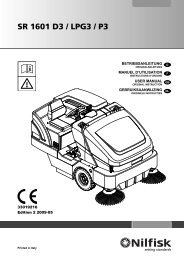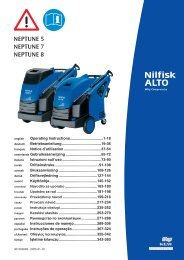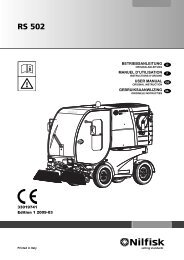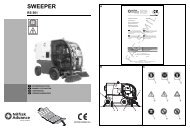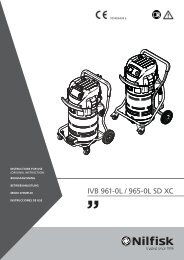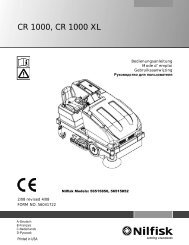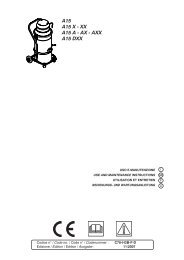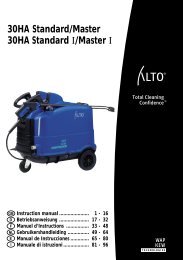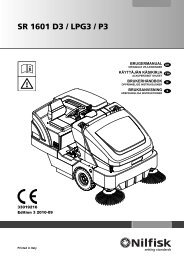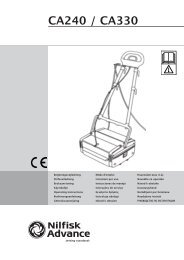3707 - 3707/10 3907 - 3907W - 3907/18 - Nilfisk PARTS
3707 - 3707/10 3907 - 3907W - 3907/18 - Nilfisk PARTS
3707 - 3707/10 3907 - 3907W - 3907/18 - Nilfisk PARTS
Create successful ePaper yourself
Turn your PDF publications into a flip-book with our unique Google optimized e-Paper software.
Mod. <strong>3707</strong> - <strong>3707</strong>/<strong>10</strong> - <strong>3907</strong> - <strong>3907</strong>W - <strong>3907</strong>/<strong>18</strong> - <strong>3707</strong>/<strong>10</strong>C - <strong>3707</strong>/<strong>10</strong>K1<br />
<strong>3707</strong>/<strong>10</strong>B1 - <strong>3907</strong>/C - <strong>3907</strong>/K1 - <strong>3907</strong>/B1 - <strong>3907</strong>W/C - <strong>3907</strong>W/K1<br />
<strong>3907</strong>W/B1 - <strong>3907</strong>/<strong>18</strong>/C - <strong>3907</strong>/<strong>18</strong>/K1 - <strong>3907</strong>/<strong>18</strong>/B1<br />
- verificare la presenza e l’integrità<br />
di tutte le protezioni.<br />
8.3.2 - Con aspiratore funzionante<br />
- Controllare che tutte le tenute<br />
pneumatiche siano perfettamente<br />
stagne.<br />
- Verificare l’efficienza di tutte<br />
le protezioni fisse.<br />
- Effettuare alcune prove di<br />
aspirazione su materiale identico<br />
a quello di produzione.<br />
Questo per verificare il corretto<br />
funzionamento dell’aspiratore<br />
in ogni suo componente.<br />
8.4 - Manutenzione<br />
periodica<br />
Per garantire una elevata<br />
affidabilità nel tempo dell’aspiratore<br />
effettuare con scrupolo i<br />
controlli di seguito elencati.<br />
8.4.1 - Prima di ogni turno<br />
di lavoro:<br />
- verificare la presenza e l’integrità<br />
di ogni targa di avvertenza<br />
e pericolo.<br />
Se incomplete o illeggibili sostituirle.<br />
- Verificare che il contenitore di<br />
raccolta detriti sia vuoto. In caso<br />
contrario provvedere al suo<br />
svuotamento. Vedi par. 6.3.<br />
- Con aspiratore acceso verificare<br />
sul manometro “1” par.<br />
6.2 il grado di efficienza del<br />
filtro.<br />
Se l’indicatore si trova sul rosso<br />
procedere alla pulizia del<br />
filtro o controllo dei tubi, come<br />
indicato al par. 8.5.4.<br />
8.4.2 - Ogni 200 ore di lavoro(mensilmente)<br />
- Verificare la tenuta delle guarnizioni.<br />
Non vi devono essere<br />
fughe.<br />
- Verificare l’integrità del tubo<br />
di aspirazione e degli accessori.<br />
Non devono presentare<br />
lacerazioni, fessurazioni o rotture<br />
che ridurrebbero il grado<br />
di efficienza d’aspirazione.<br />
- Verificare che il cavo di alimentazione<br />
non sia danneggiato,<br />
strappato o schiacciato.<br />
In tal caso procedere alla sua<br />
immediata sostituzione seguendo<br />
scrupolosamente le<br />
indicazioni riportate al par. 3.5.<br />
- check that all protections are<br />
installed and efficient.<br />
8.3.2 - With the vacuum<br />
operating<br />
- check that all the air seals are<br />
perfectly tight;<br />
- check that all fixed protections<br />
are efficient;<br />
- proceed with suction tests<br />
using the same material as<br />
that used during work.<br />
This will ascertain whether all<br />
parts of the vacuum operate<br />
correctly.<br />
8.4 - Routine maintenance<br />
Strictly comply with the following<br />
operations to ensure that the<br />
vacuum remains in a constantly<br />
reliable condition.<br />
8.4.1 - Before each work<br />
shift:<br />
- Check that all warning and<br />
danger plates are affixed and<br />
legible.<br />
Replace them if they are damaged<br />
or incomplete.<br />
- Check that the waste container<br />
is empty.<br />
Empty it if this is not the case.<br />
See paragraph 6.3.<br />
- Turn the vacuum on and check<br />
filter efficiency on gauge “1”,<br />
paragraph 6.2.<br />
If the pointer is in the red area,<br />
clean the filter or check the<br />
pipes as indicated in paragraph<br />
8.5.4.<br />
8.4.2 - Every 200 hours<br />
service (monthly)<br />
- Make sure that the seals are<br />
tight. There must be no leaks.<br />
- Check the condition of the<br />
suction hose and accessories.<br />
They must not be torn,<br />
slit or broken since this would<br />
lower the suction efficiency.<br />
- Check that the powering cable<br />
has not been damaged,<br />
torn or crushed. If this is the<br />
case, it should be immediately<br />
replaced in strict compliance<br />
with the instructions in<br />
paragraph 3.5.<br />
-75-<br />
- vérifiez la présence et le bon<br />
état detoutes les protections.<br />
8.3.2 - Avec l’aspirateur<br />
en marche<br />
- Contrôlez que toutes les étanchéités<br />
pneumatiques sont<br />
parfaitement hermétiques.<br />
- Vérifiez l’efficacité de toutes<br />
les protections fixes.<br />
- Effectuez quelques essais<br />
d’aspiration sur un déchet<br />
identique à celui de production.<br />
Ceci sert à vérifier le bon fonctionnement<br />
de tous les composants<br />
de l’aspirateur.<br />
8.4 - Entretien périodique<br />
Pour garantir une bonne fiabilité<br />
dans le temps de l’aspirateur<br />
effectuez avec soin les contrôles<br />
indiqués ci-dessous.<br />
8.4.1 - Avant chaque poste<br />
de travail<br />
- Vérifiez la présence et le bon<br />
état de chaque plaque de recommandation<br />
et danger.<br />
Si elles sont incomplètes ou<br />
illisibles les remplacer.<br />
- Vérifiez que la cuve de récupération<br />
des déchets est vide.<br />
Dans le cas contraire la vider.<br />
Voir par. 6.3.<br />
- L’aspirateur étant allumé, vérifiez<br />
sur le manomètre “1”<br />
par. 6.2 le degré l'encrassement<br />
du filtre.<br />
Si l’indicateur se trouve sur le<br />
rouge, nettoyez le filtre ou<br />
contrôlez les tuyaux, comme<br />
indiqué au par. 8.5.4.<br />
8.4.2 - Toutes les 200<br />
heures de travail<br />
(chaque mois)<br />
- Vérifiez la bonne tenue des<br />
joints d’étanchéité. Il ne doit<br />
pas y avoir de fuites.<br />
- Vérifiez le bon état du tuyau<br />
d’aspiration et des accessoires.<br />
Ils ne doivent être ni déchirés,<br />
fissurés ou cassés car<br />
ceci réduit le degré d’efficacité<br />
de l’aspiration.<br />
- Vérifiez que le câble d’alimentation<br />
n’est pas endommagé,<br />
arraché ou écrasé. Dans le<br />
cas contraire remplacez-le<br />
immédiatement en suivant<br />
scrupuleusement les indications<br />
reportées au par. 3.5.<br />
© C.F.M. S.p.A.<br />
Tutti i diritti riservati / All rights reserved<br />
Tous droits réservés / Alle Rechte vorbehalten<br />
- Sicherstellen, daß aller Schutzvorrichtungen<br />
vorhanden und<br />
unbeschädigt sind.<br />
8.3.2 - Bei laufendem<br />
Sauger<br />
- Sicherstellen, daß alle<br />
Druckluftdichtungen luftdicht<br />
abschließen;<br />
- Die Funktionstüchtigkeit aller<br />
festen Schutzvorrichtungen<br />
prüfen;<br />
- Einige Saugtests mit Material<br />
durchführen, das dem Material<br />
der Produktion entspricht.<br />
Dabei wird der Betrieb des<br />
Absaugers in allen Teilen getestet.<br />
8.4 - Wartungsplan<br />
Um die Saugleistung im Laufe<br />
der Zeit zuverlässig zu halten,<br />
sind die folgenden Prüfungen mit<br />
großer Sorgfalt auszuführen.<br />
8.4.1 - Vor Beginn jeder<br />
Arbeitsschicht:<br />
- Das Vorhandensein und die<br />
Unversehrtheit alle Warn- und<br />
Gefahrenschilder prüfen.Wenn<br />
die Schilder fehlen oder unleserlich<br />
sind, muß man sie ersetzen.<br />
- Sicherstellen, daß der Staubbehälter<br />
leer ist. Andernfalls<br />
muß er entleert werden, wie in<br />
Abschnitt 6.3 beschrieben ist.<br />
- Mit eingeschaltetem Industriesauger<br />
auf dem Manometer<br />
“1” Abs. 6.2 dem Leistungsgrad<br />
des Filters prüfen. Wenn<br />
die Kontrollanzeige im roten<br />
Bereich steht, muß man den<br />
Filter reinigen oder die Leitungen<br />
prüfen, wie in Abschnitt<br />
8.5.4 beschrieben ist.<br />
8.4.2 - Alle 200 Betriebsstunden<br />
(einmal<br />
pro Monat)<br />
- Die Dichtungen prüfen. Sie<br />
dürfen keine Leckstellen aufweisen.<br />
- Den Saugschlauch und die<br />
Zubehörteile auf Unversehrtheit<br />
prüfen. Sie dürfen keine<br />
Riß- oder Bruchstellen aufweisen,<br />
die das Saugvermögen<br />
verringern könnten.<br />
- Sicherstellen, daß das<br />
Zuleitungkabel nicht beschädigt,<br />
gequetscht oder<br />
ausgerissen worden ist. In<br />
diesem Fall muß es sofort<br />
ersetzt werden, indem man<br />
genau die Vorschriften von<br />
Abschnitt 3.5 befolgt.



